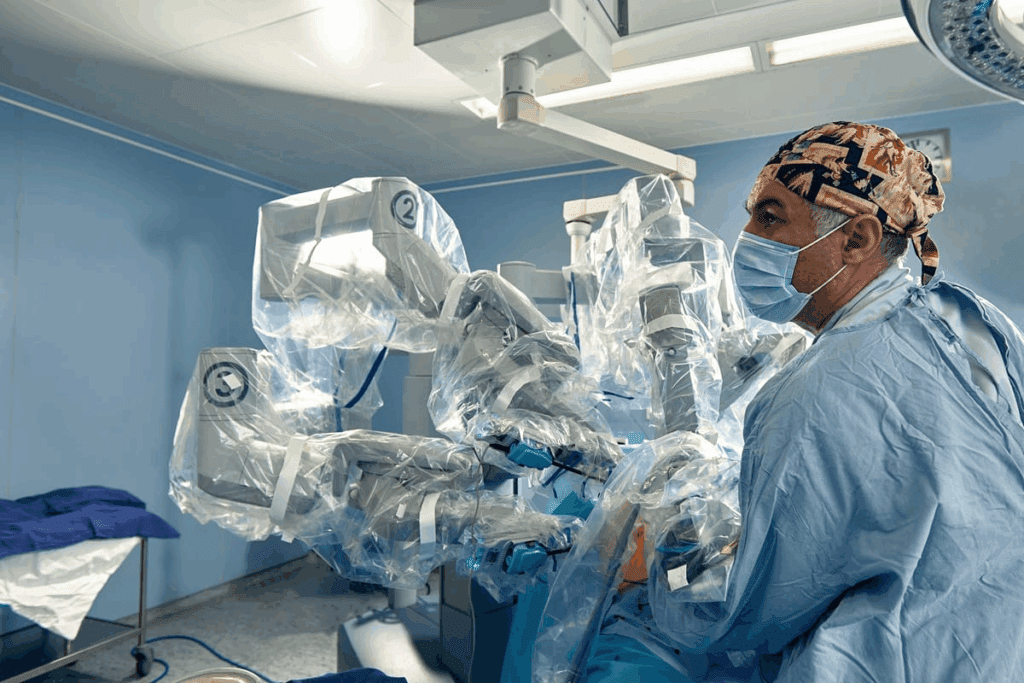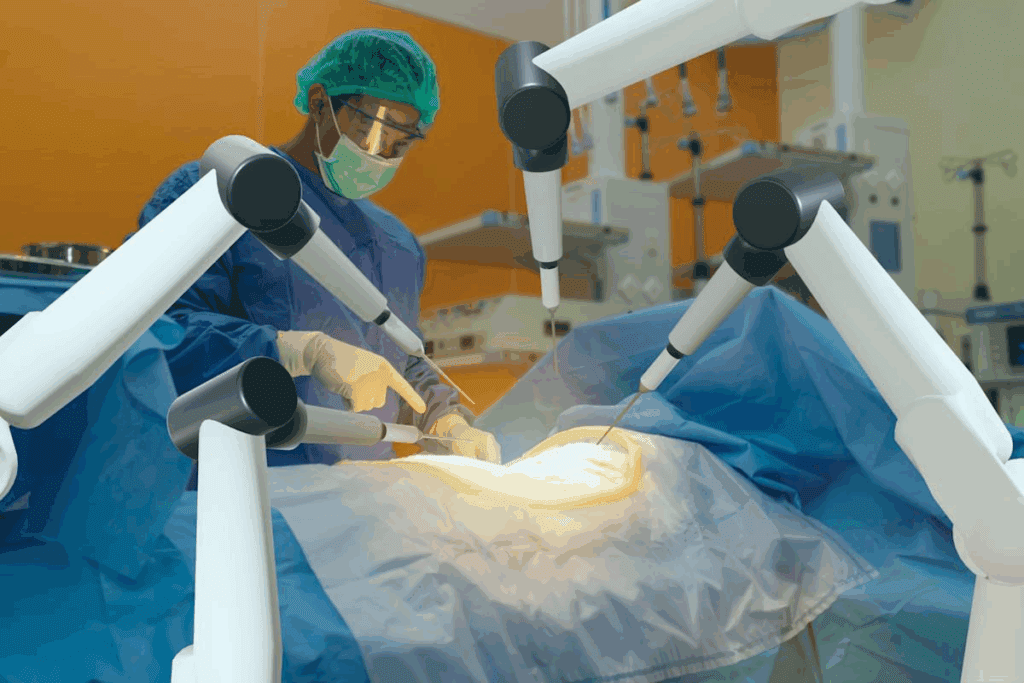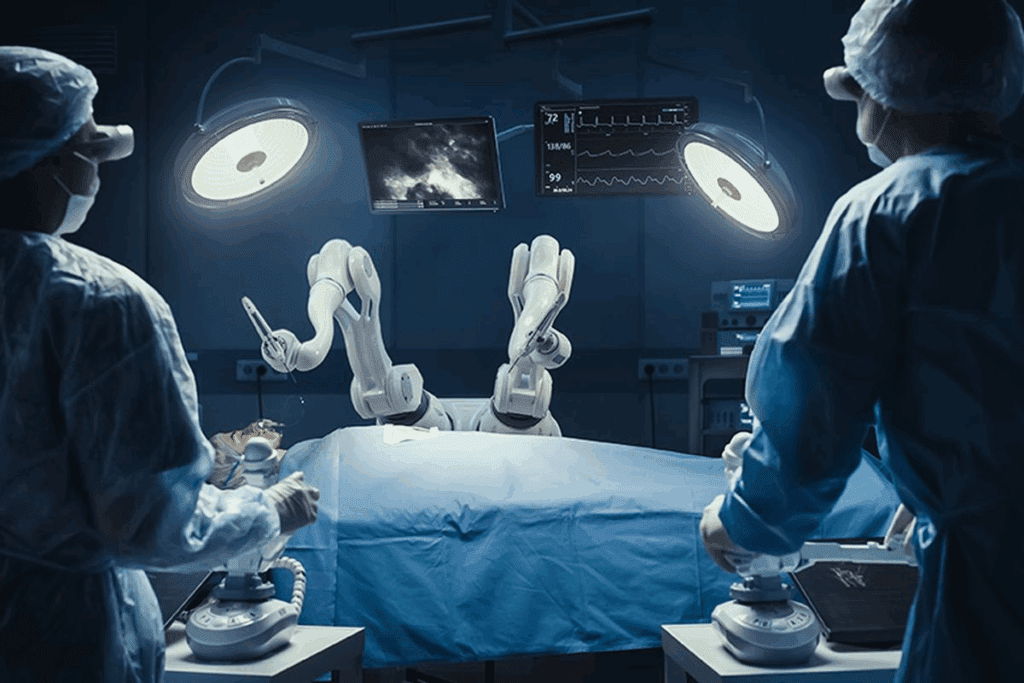Last Updated on November 27, 2025 by Bilal Hasdemir

he use of robot-assisted surgery in US hospitals has grown a lot in recent years. Now, over 2,000 hospitals use robotic surgical systems. This shows a big move towards new healthcare technology.
The North American market, led by the US, had a 51% revenue share in 2024, highlighting the country’s leadership in adopting robot surgeons. By 2020, more than 5,500 da Vinci systems were in use in the US, showing how common robotics in surgery has become.

Robotic technology is changing surgery in US hospitals. It makes operations more precise and improves patient care. Robots are now a big part of surgeries.
More hospitals are using robots for surgeries. By 2023, over 15% of surgeries were done with robots. Experts think this number could double in the next five years.
Robotic surgery systems are becoming more popular. In 2023, over 15% of surgeries in the US used robots. This number is expected to grow a lot in the future.
| Year | Robotic-Assisted Surgeries (%) |
| 2023 | 15% |
| 2028 (Projected) | 30% |
Not all states use robots for surgery the same way. Places with big hospitals and research centers use robots more. California, New York, and Texas are leading in this area.
Urban and rural hospitals differ in using robots for surgery. Cities with better medical setups adopt robots faster. But, rural areas face higher costs and less training, making it harder to use robots.
Despite these issues, efforts are underway to help rural areas. There are training programs and financial help for them.

The story of robot surgeons in American healthcare is one of fast progress and wide acceptance. Over the years, robotic surgery has moved from a new idea to a common medical practice. It has changed how surgeries are done in the United States.
The start of robotic surgery in the US was in 2000, when the FDA approved the da Vinci Surgical System. This was a big step forward. Ever after, there have been many updates in robotic tech, making surgeries more precise and controlled. The da Vinci Health Services has led in this field, giving hospitals top-notch robotic systems.
Many advancements have happened, with new companies joining the field. J&J Robotics is one of the big names, helping make robotic surgery more competitive.
Hospitals in the US have quickly taken to robotic surgery, seeing its benefits for patients and doctors. Important moments include more hospitals buying robotic systems, more procedures being done robotically, and more training for surgeons.
Robotic surgery has become a common choice for many operations. This change is because the tech improves surgery results and helps patients heal faster.
The approval process by the FDA is key for robotic surgery systems. The FDA checks these systems to make sure they are safe and work well. When new systems get approved, it pushes the industry to innovate and compete.
As tech keeps getting better, the rules for it also change. This back-and-forth between new tech and rules shapes the future of robotic surgery in American healthcare.
In US hospitals, a few companies stand out in robotic surgery. Intuitive Surgical’s da Vinci system is at the top. It has changed surgery by adding precision, flexibility, and control.
Intuitive Surgical’s da Vinci system has led robotic surgery for over 20 years. Its success in the US comes from its advanced tech, training for surgeons, and support. It’s known for precise and complex surgeries.
The da Vinci system’s lead is due to its early start, constant innovation, and many uses. This keeps Intuitive Surgical a major player in robotic surgery.
New companies like MIRA, SS Innovations, and J&J Robotics are trying to take on Intuitive Surgical. They offer new robotic systems for different needs and advantages.
MIRA focuses on flexible, precise procedures. SS Innovations aims for better visualization. J&J Robotics is working on ergonomic and controlled systems.
Intuitive Surgical’s da Vinci system has the biggest share of the US market. But, new competitors are slowly changing this.
The prices of robotic systems vary a lot. They depend on the system’s features and the vendor’s prices. As competition grows, prices might drop, making robotic surgery more available.
Robot surgeons are changing how surgeries are done in US hospitals. They bring big changes to the setup, tech, and how they fit with what’s already there.
Robot surgery needs a special setup and space. Operating rooms must be big enough for the robot gear. For example, the Da Vinci Surgical System needs a lot of room for the patient cart, console, and vision cart.
Hospitals must make sure the OR is big enough. It should also be clean and efficient.
A typical robotic OR setup includes:
The remote center of motion (RCM) technology is key in robotic surgery. It lets surgeons move precisely around a fixed point, like the incision site. This tech helps do complex surgeries with more accuracy and less harm to the patient.
RCM is very helpful in delicate surgeries, like neurosurgery and urology.
Robotic surgery systems work best when they fit with what’s already in hospitals. They need to work with electronic health records (EHRs), hospital information systems (HIS), and other medical tech. This makes sure patient data is right and easy to get, making surgeries more efficient.
| Infrastructure Component | Integration Requirement | Benefit |
| Electronic Health Records (EHRs) | Compatibility with EHR systems | Accurate and accessible patient data |
| Hospital Information Systems (HIS) | Integration with HIS for scheduling and resource allocation | Streamlined surgical workflow |
| Medical Imaging Systems | Compatibility with imaging modalities (e.g., MRI, CT) | Enhanced surgical planning and execution |
Robotic surgery has changed the medical world in the US. It lets hospitals do many surgeries with more precision and less invasion. Robotic systems are used in many medical fields.
In US hospitals, robotic surgeries include prostatectomy, gynecologic surgeries, and hernia repair. These surgeries have grown because of robotic systems. They offer less recovery time and better results.
Prostatectomy, for example, is a common treatment for prostate cancer. Robotic help makes the surgery better.
Medical specialties use robotic surgery at different rates. Urology and gynecology lead, with many procedures done robotically. Other areas, like general surgery and cardiothoracic surgery, are also using robots more.
The rate of adoption depends on the surgery’s complexity, the surgeon’s training, and the cost of robots.
The number of robotic surgeries in the US is growing fast. Last year, about 2.63 million surgeries were done with da Vinci systems. This is a 17% jump from the year before.
This growth shows how big a role robotic surgery is playing in US healthcare.
| Specialty | Percentage of Robotic Surgeries | Common Procedures |
| Urology | 40% | Prostatectomy, Nephrectomy |
| Gynecology | 30% | Hysterectomy, Endometriosis treatment |
| General Surgery | 15% | Hernia repair, Cholecystectomy |
| Cardiothoracic Surgery | 10% | Mitral valve repair, CABG |
| Other Specialties | 5% | Various procedures |
Robotic surgery is a big part of healthcare today. Urology and gynecology are leading in using it. As technology gets better, we’ll see more use in other areas too.
Hospitals in the US are adopting robotic surgery for its precision and minimally invasive nature. This approach shortens recovery times. It’s changing patient care by bringing many benefits.
Robotic surgery brings many clinical benefits. It offers better precision, dexterity, and visualization during surgery. These advantages mean less blood loss, less pain, and shorter stays for patients.
Surgeons also enjoy better ergonomics and less fatigue during long surgeries. The robot-assisted surgery systems make dissections and suturing more precise. This is key in complex surgeries, leading to better patient outcomes and fewer complications.
The initial cost of robotic surgery systems is high. But, hospitals see long-term financial gains. These include shorter stays, fewer complications, and attracting more patients.
Robotic systems also make surgical workflows more efficient. This improves resource use. Hospitals use robot-assisted surgery to stand out in a competitive market. This can lead to more patients and revenue.
Many US hospitals have seen great success with robotic surgery. For example, a top medical center reduced postoperative complications by 30%. They also cut the average length of stay by 25% for robotic surgery patients.
These stories show how robotic surgery can change healthcare. It improves patient outcomes and makes hospitals more efficient.
Robotic surgery is a game-changer, but it faces big hurdles in the US healthcare system. The main issue is the high cost of buying and keeping these systems running.
One robotic system can cost between $1.5 million and $2 million. There are also costs for upkeep, training, and updates. This makes hospitals worry about getting their money back.
A study looked into the financial side of robotic surgery. It found that while it can cut down on hospital stays and complications, the upfront and ongoing costs are heavy for many hospitals.
| Cost Component | Estimated Cost |
| Initial System Cost | $1.5M – $2M |
| Annual Maintenance | $100K – $200K |
| Training and Upgrade Costs | $50K – $100K |
For robotic surgery to work well, surgical teams need thorough training. This training covers both technical skills and knowing how to use the system.
Hospitals have to spend on training programs. These programs are expensive and take a lot of time. The training includes:
Robotic surgery systems, like those from Johnson & Johnson, need a lot of technical support and setup. Hospitals must make sure they have the right space and IT setup.
There are also logistical hurdles. Hospitals have to figure out how to fit these systems into their current workflows. They also need to make sure the surgical team and support staff can work together smoothly.
Advanced computing and AI are changing robotic surgery. They make surgeries more precise and successful. These technologies are making big changes in how surgeries are done and patient care is given.
AI is being added to robotic surgery tools. It helps with tasks like sewing or cutting tissue. For example, the Da Vinci Surgical System is getting better with AI. Real-time data analytics and learning algorithms are making surgeries more precise.
| AI Application | Current Use | Future Potencial |
| Suturing Automation | Enhancing precision in complex surgeries | Reducing surgery time and improving outcomes |
| Tissue Dissection | Improving accuracy in delicate procedures | Minimizing tissue damage and promoting healing |
Future advancements include better real-time data analytics and more AI control for surgeons. These changes will likely make surgeries even better and expand what robotic systems can do.
Using AI in robotic surgery brings up ethical issues. These include keeping patient data private and avoiding AI mistakes. It’s important to be open and get patients’ okay before using AI in their surgeries.
As AI and advanced computing keep improving robotic surgery, we must tackle these ethical problems. Doing so will help keep patients trusting and accepting of these new technologies.
Robotic surgery is changing healthcare in the US, improving patient care and making operations more efficient. Many hospitals now use systems like the Da Vinci Surgical System. With over 7,000 Da Vinci robots worldwide, this trend is set to grow.
The future of surgical robots is bright, with the market expected to reach $30 billion by 2031. Companies are working on better systems that are more precise and reduce recovery times. As robotic surgery becomes common, it will change how we get medical care, making it better and more personalized.
Artificial intelligence and advanced computing will make robotic surgery even better. This will open up new possibilities for complex surgeries and tailored treatments. As healthcare keeps changing, robotic surgery will play a bigger role in US hospitals, leading to better care and efficiency.
Robotic surgery is a new way to do surgery that uses robots to help doctors. It’s called the da Vinci Surgical System. Now, over 2,000 US hospitals use this technology.
By 2020, over 5,500 da Vinci Surgical Systems were in US hospitals. This makes it a top choice for robotic surgery.
By 2023, more than 15% of general surgeries in US hospitals were done with robots. This shows a big jump in using robotic surgery.
Robotic surgery helps patients by cutting down on blood loss and pain after surgery. It also means they can leave the hospital sooner. Doctors get better control and can see more clearly during surgery.
High costs and the need for special training are big hurdles. Hospitals also worry about getting a good return on their investment. There are technical and logistical issues to solve too.
AI is making robotic surgery better by improving accuracy and reducing problems. It also helps doctors get real-time data during surgery. We can expect even more AI in robotic surgery soon.
New players like MIRA, SS Innovations, and J&J Robotics are coming up. They aim to challenge the da Vinci’s lead in robotic surgery.
Robotic surgeons change operating rooms by needing special setups and space. They use remote technology and fit with hospital systems. This requires hospitals to adapt to new tech.
Many types of surgeries are done with robots in US hospitals. The demand for these surgeries is growing. This is because more people want less invasive procedures.
Robotic surgery in US healthcare will keep getting better with new tech like AI. As costs go down, more surgeries will be done with robots. This will change how healthcare is delivered.
Subscribe to our e-newsletter to stay informed about the latest innovations in the world of health and exclusive offers!